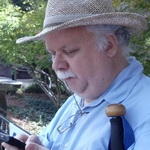First titration put me on BiPAP. Since I'm NOT on oxygen this may not be a good reference, but they just looked at my data, and deduced from that a rough range of parameters for ASV.FeelingBetter wrote:Did you guys have to go back to the sleep lab when you switched to bipap or ASV? I was recently diagnosed with secondary PAH and my AHI are in the 15-17 range and my last oximetry was >66.7% of the night with an o2 sat below 90% and I was down to 60% at times. 2 months ago only 3% of the night was below 90%. Anyway, they want me to go back to the sleep lab to either bleed in o2 or go to bipap or bipap with bled in o2. Do I really need to go back to the sleep lab for this? I really don't want the expense or the super soft bed which kills my back.
Any input will be appciated.
Centrals: When to move to BiPAP?
- RationalEntropy
- Posts: 59
- Joined: Sun Oct 30, 2011 7:49 pm
Re: Centrals: When to move to BiPAP?
Re: Centrals: When to move to BiPAP?
My husbands experience: 1st sleep study was a split night with the second half on CPAP. 2nd sleep study was with an ASV but no O2. He also has PAH and was recently hospitalized with pulmonary emboli. The doctor wrote the Rx for the ASV with supplemental O2. He'll have to have another Pulse oximetry on the ASV without the O2 before Medicare will approve it's use. It's becoming a complicated process but PAH does complicate things, as you know! I'd do the sleep study because I'd want the doctor to treat me with the most information at hand.Did you guys have to go back to the sleep lab when you switched to bipap or ASV? I was recently diagnosed with secondary PAH and my AHI are in the 15-17 range and my last oximetry was >66.7% of the night with an o2 sat below 90% and I was down to 60% at times. 2 months ago only 3% of the night was below 90%. Anyway, they want me to go back to the sleep lab to either bleed in o2 or go to bipap or bipap with bled in o2. Do I really need to go back to the sleep lab for this? I really don't want the expense or the super soft bed which kills my back.
_________________
| Mask: Swift™ FX For Her Nasal Pillow CPAP Mask with Headgear |
| Additional Comments: EPAP 5-15, PS 0-20, Auto BPM, BiFlex 2. SleepyHead software on a Mac, CMS50E Pulse Oximeter, Zeo |
My new machine is called Maria,
because: "They Call the Wind Maria"
from the musical "Paint Your Wagon"
https://www.youtube.com/watch?v=yG4rxHgq ... re=related
PS: I love my "Wind", Maria
because: "They Call the Wind Maria"
from the musical "Paint Your Wagon"
https://www.youtube.com/watch?v=yG4rxHgq ... re=related
PS: I love my "Wind", Maria
Re: Centrals: When to move to BiPAP?
My first sleep study after diagnosis was supposed to be split between CPAP and BiPAP. Somehow, I only ended up on CPAP and had more than 10 AHI at all pressures, with the central events mostly nonresponsive. The doctor has been concerned about the centrals, but wants to adjust pressure first (yes, I know the machine reports clear airway, not centrals, but it's a similar magnitude to centrals recorded in lab). Has anyone experienced decreased clear airways (especially if you had centrals in the lab) from long term use of CPAP? I'm wondering if long term usage (beyond these three months), pressure adjustment, or chasing leaks will make a difference or if I should push for a new machine.
Re: Centrals: When to move to BiPAP?
A machine scored clear airway apnea is a red flag, indicating further investigation is needed. For that matter, an in-lab PSG scored central apnea is also simply a red flag indicating further investigation is needed. Ignoring machine scored CAs because of no chest effort belt is like ignoring chest pain because the patient is not hooked up to an EKG.VikingGnome wrote:The is a misconception that "Clear Airway" apneas ARE Central Apneas. No machine for home use can detect Central Apneas because the lack of respiratory effort cannot be detected. All the machine knows is that puff of air sent from the machine did not rebound indicating an obstruction. But lack of obstruction does not mean Central Apnea. The lack of breathing must be linked with no respiratory effort by chest/abdomen muscles to be called a Central Apnea.
This is the danger of patients seeing their CPAP data and making assumptions about what they need. None of you are sleep doctors and should be very careful about what you do about the data you see.
I personally will be sharing my data with my doctor on my 60-day check-up appointment. But I will make no determination about what it means without a medical degree and Board Certified in Sleep Disorders.
Personally, I think the bigger risk is that the machine may score a true central apnea as an obstructive apnea because the patient's airway may collapse and fool the machine when the patient is having an actual central apnea.
_________________
| Mask: Swift™ FX Nasal Pillow CPAP Mask with Headgear |
| Humidifier: S9™ Series H5i™ Heated Humidifier with Climate Control |
| Additional Comments: Also SleepyHead, PRS1 Auto, Respironics Auto M series, Legacy Auto, and Legacy Plus |
Please enter your equipment in your profile so we can help you.
Click here for information on the most common alternative to CPAP.
If it's midnight and a DME tells you it's dark outside, go and check for yourself.
Useful Links.
Click here for information on the most common alternative to CPAP.
If it's midnight and a DME tells you it's dark outside, go and check for yourself.
Useful Links.
Re: Centrals: When to move to BiPAP?
Resmed would strongly disagree with you with regard to the S9 series. That's why they label those apneas as Central Apneas in Resscan and in their literature. You can read their discussion and research results here:VikingGnome wrote:The is a misconception that "Clear Airway" apneas ARE Central Apneas. No machine for home use can detect Central Apneas because the lack of respiratory effort cannot be detected. All the machine knows is that puff of air sent from the machine did not rebound indicating an obstruction. But lack of obstruction does not mean Central Apnea. The lack of breathing must be linked with no respiratory effort by chest/abdomen muscles to be called a Central Apnea.
This is the danger of patients seeing their CPAP data and making assumptions about what they need. None of you are sleep doctors and should be very careful about what you do about the data you see.
http://www.resmed.com/us/assets/documen ... -paper.pdf
_________________
| Mask: AirFit™ P10 Nasal Pillow CPAP Mask with Headgear |
| Humidifier: S9™ Series H5i™ Heated Humidifier with Climate Control |
| Additional Comments: Hose management - rubber band tied to casement window crank handle! Hey, it works! S/W is 3.13, not 3.7 |
- JohnBFisher
- Posts: 3821
- Joined: Wed Oct 14, 2009 6:33 am
Re: Centrals: When to move to BiPAP?
Sigh! Unfortunately, a few hours does not a specialist make!portiemom wrote:... The last Doctor had 30 hours training and was certified to be a sleep specialist! ...
I am fortunate that my neurologist studied specifically to become a sleep specialist. He is "board certified", with a test that takes a LOT more than 30 hours to master. You can start your search using the phrase "board certified sleep specialist". But even then you need to hunt around.
Since you are talking about "brain fog", you might want to find a neurologist who also deals with sleep medicine. You might also want to see how many patients they have and how many deal with other disorders. You want most to be there due to sleep issues, but want some to be due to other issues, since it indicates a broader area of expertise.
Best wishes in your effort to find a good sleep specialist.
_________________
| Mask: Quattro™ FX Full Face CPAP Mask with Headgear |
| Additional Comments: User of xPAP therapy for over 20 yrs. Resmed & Respironics ASV units with EEP=9cm-14cm H2O; PSmin=4cm H2O; PSmax=15cm H2O; Max=25cm H2O |
"I get up. I walk. I fall down. Meanwhile, I keep dancing” from Rabbi Hillel
"I wish to paint in such a manner as if I were photographing dreams." from Zdzisław Beksiński
"I wish to paint in such a manner as if I were photographing dreams." from Zdzisław Beksiński













